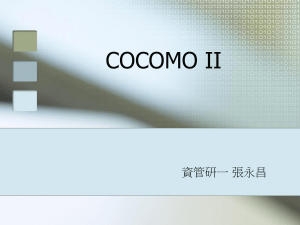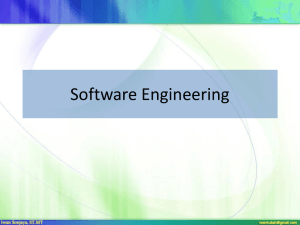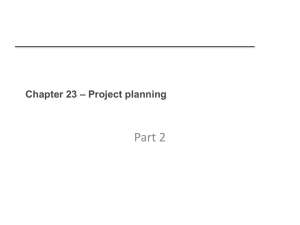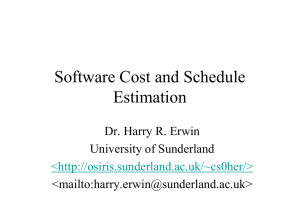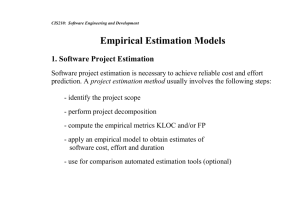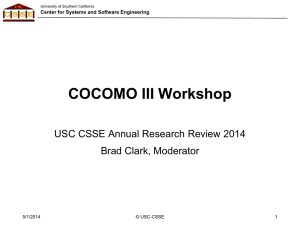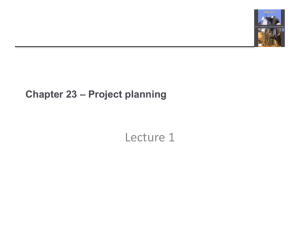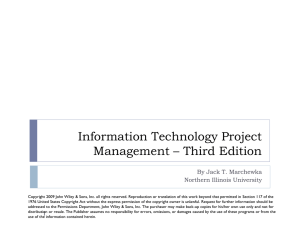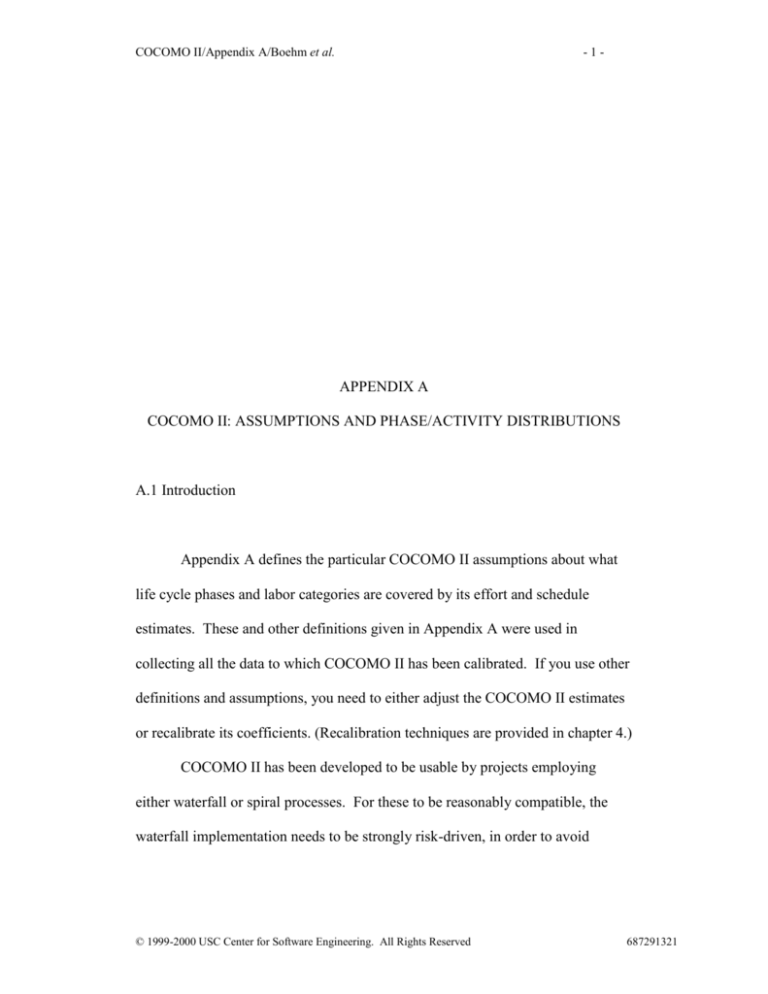
COCOMO II/Appendix A/Boehm et al.
-1-
APPENDIX A
COCOMO II: ASSUMPTIONS AND PHASE/ACTIVITY DISTRIBUTIONS
A.1 Introduction
Appendix A defines the particular COCOMO II assumptions about what
life cycle phases and labor categories are covered by its effort and schedule
estimates. These and other definitions given in Appendix A were used in
collecting all the data to which COCOMO II has been calibrated. If you use other
definitions and assumptions, you need to either adjust the COCOMO II estimates
or recalibrate its coefficients. (Recalibration techniques are provided in chapter 4.)
COCOMO II has been developed to be usable by projects employing
either waterfall or spiral processes. For these to be reasonably compatible, the
waterfall implementation needs to be strongly risk-driven, in order to avoid
© 1999-2000 USC Center for Software Engineering. All Rights Reserved
687291321
COCOMO II/Appendix A/Boehm et al.
-2-
incurring large amounts of rework not included in spiral-model-based estimates.
Fortunately, this was the case for the normative waterfall implementation
provided in Chapter 4 of [Boehm, 1981] as the underlying process model for
COCOMO 81.
The implementation of the spiral model used by COCOMO II also needs
an added feature: a set of well-defined common milestones which can serve as the
endpoints between which COCOMO II estimates and actuals are assessed. In
1995, we devoted parts of two COCOMO II Affiliates’ workshops to determining
such milestones. The result was the set of Anchor Point milestones: Life Cycle
Objectives (LCO), Life Cycle Architecture (LCA), and Initial Operational
Capability (IOC) [Boehm,1996]. Those milestones were a good fit to key life
cycle project commitment points being used within both our commercial and
government contractor Affiliate communities. The LCO and LCA milestones
involve concurrent rather than sequential development and elaboration of a
system’s operational concept, requirements, architecture, prototypes, life cycle
plan, and feasibility rationale. The milestones correspond well with real-life
commitment milestones: LCO is roughly equivalent to getting engaged; LCA to
getting married; and IOC to having your first child.
These anchor points and the stakeholder win-win extension of the spiral
model became the key milestones in our Model-Based (System) Architecting and
Software Engineering (MBASE) life cycle process model [Boehm and Port,
© 1999-2000 USC Center for Software Engineering. All Rights Reserved
687291321
COCOMO II/Appendix A/Boehm et al.
-3-
1999a; Boehm et al., 1999]. We have also collaborated with one of our Affiliates,
Rational, Inc., to ensure the compatibility of MBASE and the Rational Unified
Process (RUP). Thus, we have adopted Rational’s approach to the four main
spiral-oriented phases: Inception, Elaboration, Construction, and Transition.
Rational has adopted our definitions of the LCO, LCA, and IOC anchor point
milestones defining the entry and exit criteria between the phases [Royce, 1998;
Kruchten, 1999; Jacobson et. al., 1999].
Section A.2 proceeds to define the content of the milestones used as
endpoints for the waterfall and MBASE/RUP spiral models to which COCOMO
II project estimates are related. Section A.3 compares the phase distributions of
effort and schedule used by COCOMO II for the waterfall and initial
MBASE/RUP spiral process models. Section A.4 defines the activity categories
for the Waterfall and MBASE/RUP spiral models, and their content. Section A.5
presents the corresponding effort distributions by activity for each Waterfall and
MBASE/RUP phase. Section A.6 covers other COCOMO II assumptions, such as
the labor categories considered as "project effort," and the number of personhours in a person-month. Appendix B then builds upon the phase distributions of
effort and schedule to provide an estimation model for incremental development.
A.2 Waterfall and MBASE/RUP Phase Definitions
© 1999-2000 USC Center for Software Engineering. All Rights Reserved
687291321
COCOMO II/Appendix A/Boehm et al.
-4-
A.2.1 Waterfall Model Phases and Milestones
Table A.1 defines the milestones used as endpoints for COCOMO II
Waterfall phase effort and schedule estimates. The milestone definitions are the
same as those in [Boehm, 1981; Table 4-1].
A basic risk-orientation is provided with the inclusion of “Identification
and resolution of all high-risk development issues” as a Product Design milestone
element. However, the other early milestones should have a more risk-driven
interpretation. For example, having “…specifications validated for…feasibility”
by the end of the Plans and Requirements phase of a user-interactive system
development would imply doing an appropriate amount of user-interface
prototyping.
[Insert Table A.1]
A.2.2 MBASE and Rational Unified Process (RUP) Phases and Milestones
Table A.2 defines the milestones used as endpoints for COCOMO II
MBASE/RUP phase effort and schedule estimates (the content of the Life Cycle
Objectives (LCO) and Life Cycle Architecture (LCA) milestones are elaborated in
Table A.3). The definitions of the Inception Readiness Review (IRR) and Product
© 1999-2000 USC Center for Software Engineering. All Rights Reserved
687291321
COCOMO II/Appendix A/Boehm et al.
-5-
Release Review (PRR) have been added in Table A.2. They ensure that the
Inception and Transition phases have milestones at each end between which to
measure effort and schedule. The PRR is defined consistently with its Rational
counterpart in [Royce, 1998 and Kruchten, 1999]. The IRR was previously
undefined; its content focuses on the preconditions for a successful Inception
phase.
[Insert Table A.2]
[Insert Table A.3]
Figure A.1 shows the relationship of the Waterfall and MBASE/RUP
phases and the most likely COCOMO II model to be used in estimating effort and
schedule. The milestones have some variation due to the differences in
distribution of effort and schedule between the two models.
[Insert Figure A.1]
A.3 Phase Distribution of Effort and Schedule
Provisional phase distributions of effort and schedule are provided below
for both the Waterfall and MBASE/RUP process models. These are provisional
© 1999-2000 USC Center for Software Engineering. All Rights Reserved
687291321
COCOMO II/Appendix A/Boehm et al.
-6-
since not enough calibration data has been collected on phase distributions to
date.
The Waterfall phase distribution percentages in Table A.4 are numbers
from COCOMO 81 used in USC COCOMO II.2000. The percentages vary as
product size varies from 2 KSLOC to 512 KSLOC. The values are taken from the
COCOMO 81 Semidetached (average) mode provided in Table 6-8 of [Boehm,
1981], except for the Transition phase. This phase was undefined in COCOMO
81 and is set equal to MBASE values in Table A.5. The percentages from PRR to
SWAR add up to 100%. The percentages for Plans and Requirements and
Transition are in addition to the 100% of the effort and schedule quantities
estimated by COCOMO II.
[Insert Table A.4]
The MBASE phase distribution percentages in Table A.5 are chosen to be
consistent with those provided for the Rational UDSP in [Royce, 1998] and
[Kruchten, 1999]. They are rescaled to match the COCOMO II definition that
100% of the development effort is done in the Elaboration and Construction
phases (between the LCO and IOC milestones, for which most calibration data is
available). The corresponding figures for the UDSP development cycle are also
provided in Table A.5.
© 1999-2000 USC Center for Software Engineering. All Rights Reserved
687291321
COCOMO II/Appendix A/Boehm et al.
-7-
[Insert Table A.5]
A.3.1 Variations in Effort and Schedule Distributions
The effort and schedule distributions in the Waterfall model vary
somewhat by size, primarily reflecting the amount of integration and test required.
But the major variations in both the Waterfall model and MBASE/RUP phase
effort and schedule quantities come in the phases outside the core development
phases (Plans & Requirements and Transition for Waterfall; Inception and
Transition for MBASE/RUP).
These large variations are the main reason that the main COCOMO II
development estimates do not cover these outer phases (the other strong reason is
that calibration data is scanty for the outer phases).
At this time, there is no convenient algorithm for determining whether
your Inception phase effort will be nearer to 2% than 15% and Inception phase
schedule will be nearer to 2% than 30% of the COCOMO II development cost
estimates. The best we can offer at this time is Table A.6, which identifies the
primary effort and schedule drivers for the Inception and Transition phases.
These are presented in descending order of their effect on Inception phase
effort and schedule, and as well as possible in ascending order of their
corresponding effect on the Transition phase.
© 1999-2000 USC Center for Software Engineering. All Rights Reserved
687291321
COCOMO II/Appendix A/Boehm et al.
-8-
[Insert Table A.6]
For example, on Factor 1, the stakeholders might enter the Inception phase
with a very strong consensus that they wish to migrate some well-defined existing
capabilities to a highly feasible client-server architecture. In this case, one could
satisfy the LCO criteria with roughly 2% each of the development effort and
schedule. On the other hand, if the stakeholders entered the Inception phase with
strongly conflicting positions on desired capabilities, priorities, infrastructure,
etc., it could take up to 15% of the development effort and 30% of the
development schedule to converge to a stakeholder-consensus LCO package.
However, these differences would have a relatively low effect on the
amount of effort and schedule it would take to transition the system as defined by
the LCO. So the baseline Transition phase percentages of 12% added effort and
12.5% added schedule would be reasonable initial values to use.
Some of the Inception issues might persist into the Elaboration phase;
such persisting issues are the main source of the variations in relative effort and
schedule between the Elaboration and Construction phases shown in Table A.5.
Thus, if you estimate 30% added Inception schedule to achieve a difficult LCO
consensus, you may wish to adjust the Elaboration schedule upward from 37.5%
to something like 42%. Factors like your COCOMO II TEAM rating would
© 1999-2000 USC Center for Software Engineering. All Rights Reserved
687291321
COCOMO II/Appendix A/Boehm et al.
-9-
provide additional total effort and schedule to divide between Elaboration and
Construction.
In some cases, a factor can have a strong effect on both the Inception and
Transition phases. Factor 2 is an example: if the system’s effects involve changes
in stakeholder roles and responsibilities (e.g., turf, control, power), the amount of
effort and schedule will be increased significantly both in negotiating the changes
and implementing them.
Some additional sources of variation in phase distributions are deferred for
later versions of COCOMO II. These include phase-dependent effort multipliers
(as in Detailed COCOMO 81); effects of language level (reduced Construction
effort for very high level languages); and effects of optimizing one’s project on
development cost, schedule, or quality (partly addressed by CORADMO in
Chapter 5).
A.3.2 Distribution of Effort Across Life Cycle Phases
Figure A.2 shows the Waterfall and MBASE phases for distribution of
estimated effort. The Waterfall phase distributions are adapted from those in
[Boehm, 1981; Table 6-8]. The figure shows that distribution of effort varies by
size of the product and the size exponent, E. The size exponent E corresponds to
the three modes in COCOMO 81. Note that the effort distribution for a small
© 1999-2000 USC Center for Software Engineering. All Rights Reserved
687291321
COCOMO II/Appendix A/Boehm et al.
- 10 -
project with a low value for E has the most effort in the Code and Unit Test phase.
The top line shows this condition. A large project with a value of E has the most
effort concentrated in the Integration and Test phase. This is shown by the
bottom line. These distributions of effort are for a Waterfall model project where
the development is done in a single sequence through the phases.
[Insert Figure A.2]
The MBASE distribution of effort is taken from Table A.5. The
distribution of effort in the table is 72 to 80 % for the Construction phase which
includes Detailed Design, Code and Unit Test, and Integration and Test. The
shaded areas in Figure A.2 are approximations of the distribution of the
Construction effort.
Contrast the Waterfall distributions with the MBASE/RUP distributions.
MBASE/RUP emphasizes planning up front and smaller, repeated iterations to
develop the product. This makes the distribution of effort less dependent on size
and scale factors. The iterative approach also starts the product integration earlier
reducing large-system integration gridlock that can occur if integration is left till
the last step (as in the Waterfall model).
A.3.3 Distribution of Schedule Across Life Cycle Phases
© 1999-2000 USC Center for Software Engineering. All Rights Reserved
687291321
COCOMO II/Appendix A/Boehm et al.
- 11 -
Figure A.3 shows the Waterfall and MBASE phase distribution of
estimated schedule. The waterfall distributions are taken from [Boehm 1981;
Table 6-8]. As with effort discussed above, schedule varies with size and the
scale factor. The two lines bound the range of Waterfall schedule distribution
showing a small easy project and a large difficult project.
The MBASE schedule distribution is taken from Table A.5. The shaded
areas show the range of distribution for each phase.
[Insert Figure A.3]
A.4 Waterfall and MBASE/RUP Activity Definitions
A.4.1 Waterfall Model Activity Categories
The COCOMO II Waterfall model estimates effort for the following eight major
activities [Boehm, 1981; Table 4-2]:
Requirements Analysis: Determination, specification, review and
update of software functional, performance, interface, and verification
requirements.
© 1999-2000 USC Center for Software Engineering. All Rights Reserved
687291321
COCOMO II/Appendix A/Boehm et al.
- 12 -
Product Design: Determination, specification, review and update of
hardware-software architecture, program design, and database design.
Programming: Detailed design, code, unit test, and integration of
individual computer program components. Includes programming
personnel planning, tool acquisition, database development,
component level documentation, and intermediate level programming
management.
Test Planning: Specification, review, and update of product test and
acceptance test plans. Acquisition of associated test drivers, test tools,
and test data.
Verification and Validation: Performance of independent requirements
validation, design V & V, product test, and acceptance test.
Acquisition of requirements and design V & V tools.
Project Office Functions: Project level management functions.
Includes project level planning and control, contract and subcontract
management, and customer interface.
Configuration Management and Quality Assurance: Configuration
management includes product identification, change control, status
accounting, operation of program support library, development and
monitoring of end item acceptance plan. Quality assurance includes
© 1999-2000 USC Center for Software Engineering. All Rights Reserved
687291321
COCOMO II/Appendix A/Boehm et al.
- 13 -
development and monitoring of project standards, and technical audits
of software products and processes.
Manuals: Development and update of users’ manuals, operators’
manuals, and maintenance manuals.
When the COCOMO II model is used to estimate effort, the estimated
effort can be distributed across the major activities. Section A.5 provides the
percentage distributions of activity within each phase.
A.4.2 Waterfall Model Work Breakdown Structure
The COCOMO II Waterfall and MBASE/RUP activity distributions are
defined in more detail via work breakdown structures. Table A.7 shows a work
breakdown structure outline adapted from [Boehm 1981; Figure 4-6B]. This WBS
excludes the requirements-related activities done up to SRR.
[Insert Table A.7]
A.4.3 MBASE/RUP Model Activity Categories
A.4.3.1 Background
© 1999-2000 USC Center for Software Engineering. All Rights Reserved
687291321
COCOMO II/Appendix A/Boehm et al.
- 14 -
This section defines phase and activity distribution estimators for projects
using the life cycle model provided by USC’s Model-Based (System)
Architecting and Software Engineering (MBASE) approach and the Rational
Unified Process (RUP). Booth MBASE and RUP use the same phase definitions
and milestones. MBASE has a more explicit emphasis on a stakeholder win-win
approach to requirements determination and management. RUP accommodates
such an approach but more as an option.
In developing these estimators, we have tried to maintain strong
consistency with the published Rational phase and activity distributions in
[Royce, 1998; Kruchten, 1999; and Jacobson-Booch-Rumbaugh, 1999], and with
the published anchor point/MBASE phase boundary definitions in [Boehm, 1996;
and Boehm-Port, 1999]. We have iterated and merged drafts of the estimators
and definitions with Rational.
Our main sources of information on the Rational phase and activity
distributions are:
The common table of default estimators of effort and schedule
distribution percentages by phase on page 148 of Royce, page 118 of
Kruchten, and page 335 of Jacobson et al.
© 1999-2000 USC Center for Software Engineering. All Rights Reserved
687291321
COCOMO II/Appendix A/Boehm et al.
- 15 -
The default estimators of total project activity distribution percentages
in Table 10-1, page 148 of Royce. These in turn draw on the
definitions of the activity categories in Royce’s Life Cycle Phase
Emphases (Table 8-1, page 120) and Default Work Breakdown
Structure --WBS-- (Figure 10-2, pages 144-145).
We and Rational agree that these and the COCOMO table values below
cannot fit all project situations, and should be considered as draft values to be
adjusted via context and judgement to fit individual projects. As discussed in
Section 5.2 on our emerging constructive Phase Schedule and Effort Model
(COPSEMO), we have research activities underway to provide stronger guidance
on the factors affecting phase and activity distributions.
A.4.3.2 Phase and Activity Category Definitions
Thus, we have begun with the overall phase and activity distributions in
[Royce, 1998], and used these to develop a set of default MBASE/RUP phase
and activity distributions for use in COCOMO II as a counterpart to those
provided for the waterfall model. In the process, we found the need to elaborate a
few of the activity-category definitions in Royce’s Figure 10-2 (e.g., including
configuration management within Environment; adding stakeholder coordination
© 1999-2000 USC Center for Software Engineering. All Rights Reserved
687291321
COCOMO II/Appendix A/Boehm et al.
- 16 -
as a Management activity and stakeholder requirements negotiation as a
Requirements activity; and including explicit Transition Plan and Evolution Plan
activities in Deployment). We also modified a few definitions and allocations
(using “evolution” in place of “maintenance;” splitting “Business case
development” and “Business case analysis” between Management and
Assessment).
For comparison, we have reproduced the Royce’s WBS as Table A.8 and
provided the counterpart COCOMO II WBS as Table A.9. We have also
orthogonalized the WBS organization in Table A.9 (e.g., for each phase X, the
planning WBS element is AXA and the control element is AXB), and provided
more explicit categories corresponding to the Level 2 and 3 project-oriented Key
Process Areas in the SEI Capability Maturity model. An exception is Software
Quality Assurance, where we agree with Royce that all activities and all people
are involved in SQA, and that a separate WBS element for QA is inappropriate.
[Insert Table A.8]
[Insert Table A.9]
A.5 Distribution of Effort Across Activities
© 1999-2000 USC Center for Software Engineering. All Rights Reserved
687291321
COCOMO II/Appendix A/Boehm et al.
- 17 -
A.5.1 Waterfall Model Activity Distribution
Tables A.10a through A.10d, adapted from [Boehm 1981; Tables 7-1,2,3],
show the distribution of eight major activities (discussed in Section A.4.1) across
the estimated project effort per phase. The activity distribution values are
interpolated for projects that are between values in the table.
For example, a project with size 128 KSLOC and an exponent of 1.12
would spend 28% of its effort in Integration and Test, see Table A.10d Overall
Phase Percentage row. From Table A.10d we see that the Requirement Analysis
activity takes 2.5% of the 28%, Product Design takes 5% of the 28%,
Programming takes 39% of the 28%, and so on. We see that the activity tables
break up the estimated effort for a phase into the different activities that occur
during the phase.
[Insert Table A.10a]
[Insert Table A.10b]
[Insert Table A.10c]
[Insert Table A.10d]
© 1999-2000 USC Center for Software Engineering. All Rights Reserved
687291321
COCOMO II/Appendix A/Boehm et al.
- 18 -
The last two activity tables handle the situation where development or
maintenance is performed as a level of effort. In other words, there is a fixed
amount of staff that will be working on the project and the eight major activities
are divided among the fixed staffing.
As an example, a maintenance project has 10 staff for 12 months (120
Person Months), a size of 8 KSLOC, and an exponent of 1.20. From Table 10f
we see that Requirements Analysis will consume 6% of the staff’s effort or 7.2
PM, Program Design will consume 11% of the staff’s effort or 13.2 PM,
Programming will consume 39% of the staff’s effort or 46.8 PM, and so on.
[Insert Table A.10e]
[Insert Table A.10f]
A.5.2 MBASE/RUP Model Activity Distribution Values
Table A.11 shows the resulting COCOMO II MBASE/RUP default phase
and activity distribution values. The first two lines show the Rational and
COCOMO II schedule percentages by phase. Their only difference is that the
Rational percentages sum to 100% for the full set of Inception, Elaboration,
Construction, and Transition phases (IECT), while COCOMO II counts the core
© 1999-2000 USC Center for Software Engineering. All Rights Reserved
687291321
COCOMO II/Appendix A/Boehm et al.
- 19 -
Elaboration and Construction phases as 100%. This is done because the scope
and duration of the Inception and Transition phases are much more variable, and
because less data is available to calibrate estimation models for these phases. For
COCOMO II, this means that the current model covering the Elaboration and
Construction phases is considerably more accurate and robust than we could
achieve with counterpart models that would include the Inception and/or
Transition phases.
Lines 1 and 2 in Table A.11 show the Rational and COCOMO II phase
distributions for the project’s schedule in months. Lines 3 and 4 in Table A.11
show the corresponding phase distributions for effort. The sum of the COCOMO
II percentages for the total IECT project span is 125% for schedule and 118% for
effort.
[Insert Table A.11]
Lines 6-12 in Table A.11 show the default percentage of effort by activity
for each of the MBASE/RUP phases. For example, the Management activities are
estimated to consume 14% of the effort in the Inception phase, 12% in the
Elaboration phase, 10% in Construction, and 14% in Transition. For the total
IECT span, the Management activities consume
© 1999-2000 USC Center for Software Engineering. All Rights Reserved
687291321
COCOMO II/Appendix A/Boehm et al.
- 20 -
(14%)(6%) + (12%)(24%) + (10%)(76%) + (14%)(12%) = 13%
This sum is slightly larger but quite comparable to the IECT percentage of
12% derived from Royce’s Table 10-1. The WBS definitions in Tables A.8 and
A.9 are sufficiently similar that the values in Table A.11 can be applied equally
well to both.
These values can be used to determine draft project staffing plans for each
of the phases. For example, the 100 KSLOC, all nominal manufacturing control
system (MCS) used as an example in Section 2.6 had an estimated development
effort of 466 PM and an estimated schedule of 26 months. From lines 2 and 4 of
Table A.11, we can compute the estimated schedule and effort of the Construction
phase as:
Schedule: (26 Mo.) (.625) = 16.25 Mo.
Effort: (466 PM) (.76) = 354 PM
The average staff level of the Construction phase is thus:
354 PM/ 16.25 Mo. = 21.8 persons.
© 1999-2000 USC Center for Software Engineering. All Rights Reserved
687291321
COCOMO II/Appendix A/Boehm et al.
- 21 -
We can then use lines 6-12 of Table A.11 to provide a draft estimate of
what these 21.8 persons will be doing during the Construction phase. For
example, the estimated average number of personnel performing Management
activities is:
(21.8 persons) (.10) = 2.2 persons
Table A.12 shows the full set of draft activity estimates for the
Construction phase.
[Insert Table A.12]
These staffing estimates can be used for other purposes as well. When
multiplied by associated average labor costs for activity categories, they can be
used as starting points for project WBS and budget allocations, or for earned
values associated with phase deliverables.
It is important to understand that these numbers are just draft starting
points for the actual numbers you use to manage your project. Every project will
have special circumstances which should be considered in adjusting the draft
values (see also [Royce, p. 218], [Kruchten, pp.118-119], and [Jacobson-BoochRumbaugh, p. 336]). For example, an ultra-reliable product will have higher
© 1999-2000 USC Center for Software Engineering. All Rights Reserved
687291321
COCOMO II/Appendix A/Boehm et al.
- 22 -
Assessment efforts and costs; a project with a stable environment already in place
will have lower up-front Environment efforts and costs. The COCOMO II
research agenda includes activities to provide further guidelines for adjusting the
phase and activity distributions to special circumstances. Even then, however, the
estimated phase and activity distribution numbers should be subject to critical
review. As with other COCOMO II estimates, the phase and activity distribution
estimates should be considered as a stimulus to thought, and not as a substitute for
thought.
A.6
Definitions and Assumptions
COCOMO II’s definitions and assumptions are similar to those for COCOMO
81 [Boehm 1981, pp. 58-61], but with some differences. Here is a summary of
similarities and differences:
1. Sizing. COCOMO 81 just used Delivered Source Instructions for sizing.
COCOMO II uses combinations of Function Points (FP) and Source Lines of
Code for the Early Design and Post-Architecture models, with counting rules
in [IFPUG 1994] for FP and Chapter 2 for SLOC. The emerging Applications
Composition model uses Application Points for sizing, as defined in Section
5.1.
© 1999-2000 USC Center for Software Engineering. All Rights Reserved
687291321
COCOMO II/Appendix A/Boehm et al.
- 23 -
2. Development Periods Included. For the Waterfall process model, COCOMO
II uses the same milestone endpoints (Software Requirements Review to
Software Acceptance Review) as COCOMO 81. For the MBASE/RUP
process model, COCOMO II uses the Life Cycle Objectives and Initial
Operational Capability milestone as endpoints for counting effort and
schedule. Details for both are in Appendix A.2.
3. Project Activities Included. For the Waterfall process model, COCOMO II
includes the same activities as did COCOMO 81. For the MBASE and RUP process
models, the Work Breakdown Structures in Appendix A.4 define the project activities
included by phase. For all the models, all software development activities such as
documentation, planning and control, and configuration management (CM) are
included, while database administration is not. For all the models, the software
portions of a hardware-software project are included (e.g., software CM, software
project management) but general CM and management are not. Both models have
add-on efforts for a front-end phase (Plans and Requirements for COCOMO 81;
Inception for (MBASE/RUP). COCOMO II differs from COCOMO 81 in having
add-on efforts for a back-end Transition phase, including conversion, installation, and
training. As discussed in Appendix A.3 the size of these add-on efforts can vary a
great deal, and their effort estimates should be adjusted for particularly small or large
add-on endeavors.
4. Labor categories included. COCOMO 81 and COCOMO II estimates both use the
same definitions of labor categories included as direct-charged project effort vs.
© 1999-2000 USC Center for Software Engineering. All Rights Reserved
687291321
COCOMO II/Appendix A/Boehm et al.
- 24 -
overhead effort. Thus, they include project managers and program librarians, but
exclude computer center operators, personnel-department personnel, secretaries,
higher management, janitors, and so on.
5. Dollar Estimates. COCOMO 81 and COCOMO II avoid estimating labor costs in
dollars because of the large variations between organizations in what is included in
labor costs, e.g. unburdened (by overhead cost), burdened, including pension plans,
office rental, and profit margin. Person months are a more stable quantity than
dollars given current inflation rates and international money fluctuations.
6. Person-month definition. A COCOMO person-month consists of 152 hours of
working time. This has been found to be consistent with practical experience with the
average monthly time off due to holidays, vacation, and sick leave. To convert a
COCOMO estimate in person-months to other units, use the following:
Person-hours: multiply by 152
Person-days: multiply by 19
Person-years: divide by 12
Some implementations, such as USC COCOMO II, provide an adjustable parameter
for the number of person-hours per person-month. Thus, if you enter 137 (10% less)
for this parameter, USC COCOMO II will increase your person-month estimate by
10%, and calculate an appropriately longer development schedule.
© 1999-2000 USC Center for Software Engineering. All Rights Reserved
687291321



